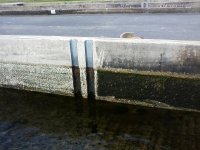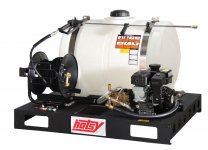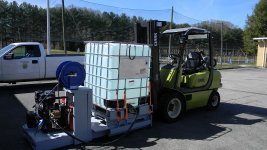I'm an employee at a national fish hatchery; and as such (being an employee with only recommendation power), I am very limited on the equipment I can push for with respect to dollars, and the setup that we are constrained to work within. There are lots of details that I could get in to about our constraints if anyone would like for me to get in to all of that, but what it boils down to is that our set up right has to be 100% mobile with a forklift as the normal means of moving our equipment around including water. We have two 330-gallon, reconditioned IBC totes that I had to beg for. Previously, we used our distribution trucks (which have a primary use other than PWing) and/or smaller water tanks that had to be constantly refilled, and/or insufficient, 350-gallon water tanks with only a 1/2" discharge valve to do the work. Previously, we used two smaller, direct-drive units (2.4 GPM/3000 PSI) that would not hold up with our insufficient gravity fed system (we did not know about cavitation, benefits of belt drive, sufficient GPM supply; no air leaks, and all that stuff back then). Previously, it would take us 3.5-4 hrs to complete one concrete fish rearing unit with one pressure washer and around 2.5 hrs using two. Now it takes us roughly 1.5-2 hrs using a much better, 3.7 GPM/3500 PSI, belt drive unit.
The first thing I know you guys will ask is why we don't run plumbing lines down closer to our work sites, but suffice it to say, that's not something I can get done right now with the current leadership. I'm already pushing the limits with what we've got now. I've recently built a platform out of treated lumber that houses the water tote, pressure washer, hose reel that I carefully talked the boss in to letting us purchase, and other equipment (like a water blocking screen). This allows us to move everything in one trip which is beneficial when the forklift is being used for other purposes at the same time. I built this platform over a period of four weeks; mostly during my lunch time and coming in early, because, the bosses would not have been able to give me the time to build it otherwise. I'm not really a construction-minded person, so this was a real struggle for me to execute, but it turned out decent. It's 92 inches long and 43 inches wide and when the water tote is empty, it can be lifted from the pressure washer end to lift up and put in a 3/4-ton pickup when we need to. The hose reel is wonderful. I should have talked the boss in to one of those a long time ago. I had to build a secondary level deck on my platform to house the hose reel, but the effort was worth it.
I've been shopping and researching extensively for a second pressure washer, which we'll get a little money for this Spring, and I've come up with something that's going to cost our field station $1762 delivered. I think is the best value I've found with the minimum capability and feature wise that we need to do the work efficiently. However, the last pressure washer we got cost us $1650, and that was really pushing the limits with what the bosses feel like we should spend on a pressure washer set up. The new one I have in mind offers a few things our first one doesn't. (1) a place to mount a hose reel without building a deck to put it on; (2) a roll cage, steel frame to protect the unit from the blocker screen or anything else that might fall on it. I had to build a rail on my current platform to protect our existing unit; a framed unit would simplify constructing my next platform. (3) Unlike the picture below, the unit I have a quote on is skid mount, which would simplify mounting to my next platform. (4) The new one, if they let us have it, is slightly more capable @ 4GPM/4000PSI, which should speed us up even more, but yet not so high a GPM that we couldn't complete one fish rearing unit w/o running out of water. And (5) most importantly, this unit has a 6-gallon tank. This would give us roughly two days worth of work w/o filling up. My current platform had to be designed to house a 5 gallon gas can. A unit with a 6-gallon tank would allow me to build a simpler; not so long platform, which, since it's not going to be all that long, it won't have to be quite so strong.

In addition, we need at least 75' of pressure hose (this unit comes with 50'), and we need a hose reel, which does not come with the unit as pictured. A turbo tip would be something that I'd like to try as well. Electric start would be nice, but that'd probably being pushing it a little too much. I'd like to one day look in to a sweeper and/or a trolley to speed us up even more, and if we had access to spigots, I'd like to upgrade to an 8 GPM unit, but all of that is just wishful thinking at this point.
My strategy: I think my best strategy is to ask for this $1762 unit; suggest that we can get elec. start for $300 more (but don't expect that they'd say yes); and then sort of piece mill request a 100' pressure hose, then a hose reel, and then a turbo tip, sort of one at a time.
If you expert folks made it through most of my convoluted post, you've probably got lots of questions and confused about alot of things, and I don't care to answer any questions. I've got pictures of my current set up, but the camera is at work, so I'll have to get that if anyone wants to see what I've got. The odd thing about all of this is that every time that I've talked the supervisors into an upgrade, they see the value of it on productivity. The problem I'm having (at least the way I perceive it) is that, since we're gov't, productivity isn't always seen with the same value as in the real world, and that's why it's been such a struggle to get them to cough up money for things that make us so much more productive.
Any suggestions or feedback about positive or negative about the equipment choices I have in mind would be helpful. I think the brand of unit from above is Pressure Pro, however, I've not seen a single unit sold by anyone else other than the one seller I found it from, and so I'm not sure exactly where they are sourcing the frame.
The first thing I know you guys will ask is why we don't run plumbing lines down closer to our work sites, but suffice it to say, that's not something I can get done right now with the current leadership. I'm already pushing the limits with what we've got now. I've recently built a platform out of treated lumber that houses the water tote, pressure washer, hose reel that I carefully talked the boss in to letting us purchase, and other equipment (like a water blocking screen). This allows us to move everything in one trip which is beneficial when the forklift is being used for other purposes at the same time. I built this platform over a period of four weeks; mostly during my lunch time and coming in early, because, the bosses would not have been able to give me the time to build it otherwise. I'm not really a construction-minded person, so this was a real struggle for me to execute, but it turned out decent. It's 92 inches long and 43 inches wide and when the water tote is empty, it can be lifted from the pressure washer end to lift up and put in a 3/4-ton pickup when we need to. The hose reel is wonderful. I should have talked the boss in to one of those a long time ago. I had to build a secondary level deck on my platform to house the hose reel, but the effort was worth it.
I've been shopping and researching extensively for a second pressure washer, which we'll get a little money for this Spring, and I've come up with something that's going to cost our field station $1762 delivered. I think is the best value I've found with the minimum capability and feature wise that we need to do the work efficiently. However, the last pressure washer we got cost us $1650, and that was really pushing the limits with what the bosses feel like we should spend on a pressure washer set up. The new one I have in mind offers a few things our first one doesn't. (1) a place to mount a hose reel without building a deck to put it on; (2) a roll cage, steel frame to protect the unit from the blocker screen or anything else that might fall on it. I had to build a rail on my current platform to protect our existing unit; a framed unit would simplify constructing my next platform. (3) Unlike the picture below, the unit I have a quote on is skid mount, which would simplify mounting to my next platform. (4) The new one, if they let us have it, is slightly more capable @ 4GPM/4000PSI, which should speed us up even more, but yet not so high a GPM that we couldn't complete one fish rearing unit w/o running out of water. And (5) most importantly, this unit has a 6-gallon tank. This would give us roughly two days worth of work w/o filling up. My current platform had to be designed to house a 5 gallon gas can. A unit with a 6-gallon tank would allow me to build a simpler; not so long platform, which, since it's not going to be all that long, it won't have to be quite so strong.
In addition, we need at least 75' of pressure hose (this unit comes with 50'), and we need a hose reel, which does not come with the unit as pictured. A turbo tip would be something that I'd like to try as well. Electric start would be nice, but that'd probably being pushing it a little too much. I'd like to one day look in to a sweeper and/or a trolley to speed us up even more, and if we had access to spigots, I'd like to upgrade to an 8 GPM unit, but all of that is just wishful thinking at this point.
My strategy: I think my best strategy is to ask for this $1762 unit; suggest that we can get elec. start for $300 more (but don't expect that they'd say yes); and then sort of piece mill request a 100' pressure hose, then a hose reel, and then a turbo tip, sort of one at a time.
If you expert folks made it through most of my convoluted post, you've probably got lots of questions and confused about alot of things, and I don't care to answer any questions. I've got pictures of my current set up, but the camera is at work, so I'll have to get that if anyone wants to see what I've got. The odd thing about all of this is that every time that I've talked the supervisors into an upgrade, they see the value of it on productivity. The problem I'm having (at least the way I perceive it) is that, since we're gov't, productivity isn't always seen with the same value as in the real world, and that's why it's been such a struggle to get them to cough up money for things that make us so much more productive.
Any suggestions or feedback about positive or negative about the equipment choices I have in mind would be helpful. I think the brand of unit from above is Pressure Pro, however, I've not seen a single unit sold by anyone else other than the one seller I found it from, and so I'm not sure exactly where they are sourcing the frame.






